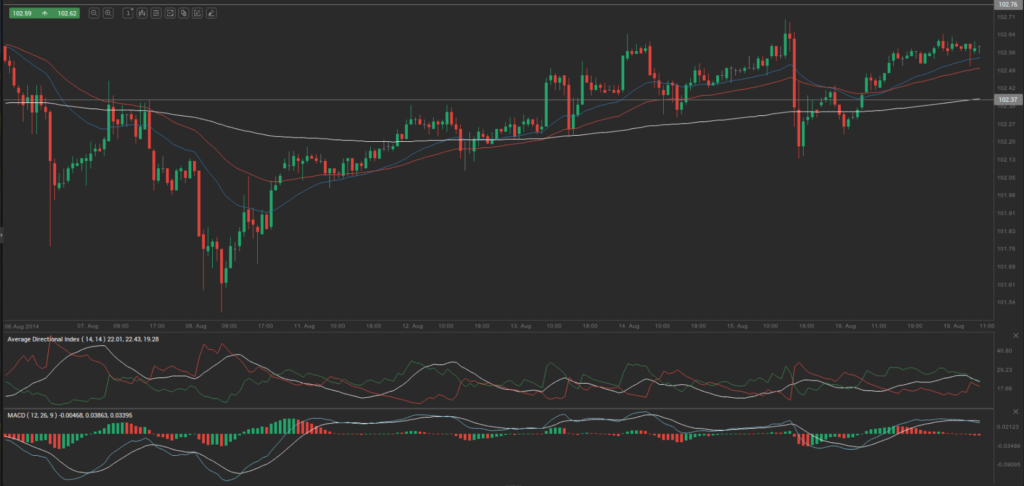Yesterday’s trade saw USD/JPY within the range of 102.25-102.64. The pair closed at 102.63, gaining 0.21% on a daily basis.
At 8:16 GMT today USD/JPY was up 0.03% for the day to trade at 102.60. The pair touched a daily high at 102.66 during the Asian trading session.
Fundamental view
United States
The annualized index of consumer prices (CPI) in the United States probably remained steady at 2.0% in July, according to market expectations. In monthly terms, the CPI probably increased 0.1% last month, following another 0.3% gain in June.
The CPI is based on a basket of goods and services bought and used by consumers on a daily basis. In the United States the Bureau of Labor Statistics (BLS) surveys the prices of 80 000 consumer items in order to calculate the index. The latter reflects prices of commonly purchased items by primarily urban households, which represent about 87% of the US population. The Bureau processes price data from 23 000 retail and service businesses.
The CPI includes sales taxes, but excludes income taxes, prices of investments such as stocks and bonds and sales prices of homes.
The annualized Core CPI, which excludes prices of food and energy, probably remained unchanged at 1.9% in July. It is usually reported as a seasonally adjusted figure, because consumer patterns are widely fluctuating in dependance on the time of the year. The Core CPI is a key measure, because this is the gauge, which the Federal Reserve Bank examines in order to adjust its monetary policy. The Fed uses the core CPI, because prices of food, oil and gas are highly volatile and central bank’s tools are slow-acting. In case prices of gas surge considerably, this could lead to a high rate of inflation, but the central bank will not take action until this increase affects prices of other goods and services.
If the CPI tends to approach or comes in line with the inflation objective, set by the Federal Reserve and considered as providing price stability, or 2%, this will usually support demand for the US dollar. However, quite high rates of inflation (well above central bank’s inflation target) can be harmful to economy and as a result, this may lead to the loss of confidence in the local currency.
The Bureau of Labor Statistics is to release the official CPI report at 12:30 GMT.
The number of housing starts in the United States probably rose to 0.970 million in July from 0.893 million during the prior month. Housing Starts represent a gauge to measure residential units, on which construction has already begun, every month. A start in construction is defined as the foundation laying of a building and it encompasses residential housing primarily.
The number of building permits in the country probably increased to 1.000 million in July compared to a month ago, according to the median estimate by experts. In June permits, issued by the government, have been revised up to 0.973 million units from 0.963 million units, as reported previously.
Building permits are permits, issued in order to allow excavation. An increase in the number of building permits and housing starts usually occurs a few months after mortgage rates in the country have been reduced. Permits usually lead housing starts, but are not required in all regions of the United States. Building permits, as an indicator, provide information regarding demand in US housing market. A higher than anticipated number would support the greenback. The official data by the US Census Bureau is due out at 12:30 GMT.
Japan
The deficit on Japanese seasonally adjusted trade balance probably narrowed to 0.770 trillion JPY during July from a deficit of 1.081 trillion JPY, registered in June. The trade balance, as an indicator, measures the difference in value between country’s exported and imported goods and services during the reported period. A positive balance signifies a trade surplus and a negative balance signifies a trade deficit. The balance of trade reflects the net export of goods and services, or one of the components to form country’s Gross Domestic Product.
Annualized exports probably rose 3.8% last month, following a drop of 2.0% in June. Annualized imports probably decreased 1.7% in July, after a surge of 8.4% in the preceding month. Generally, exports reflect economic growth, while imports indicate domestic demand. In case the trade balance deficit contracted more than anticipated, this would provide support to the yen. The Ministry of Finance will release the official numbers at 23:50 GMT.
On August 8th Bank of Japan revised down its projections regarding nations exports and manufacturing activity.
Technical view
According to Binary Tribune’s daily analysis, the central pivot point for the pair is at 102.51. In case USD/JPY manages to breach the first resistance level at 102.76, it will probably continue up to test 102.90. In case the second key resistance is broken, the pair will probably attempt to advance to 103.15.
If USD/JPY manages to breach the first key support at 102.37, it will probably continue to slide and test 102.12. With this second key support broken, the movement to the downside will probably continue to 101.98.
The mid-Pivot levels for today are as follows: M1 – 102.05, M2 – 102.25, M3 – 102.44, M4 – 102.64, M5 – 102.83, M6 – 103.03.
In weekly terms, the central pivot point is at 102.40. The three key resistance levels are as follows: R1 – 102.67, R2 – 102.97, R3 – 103.24. The three key support levels are: S1 – 102.10, S2 – 101.83, S3 – 101.53.






